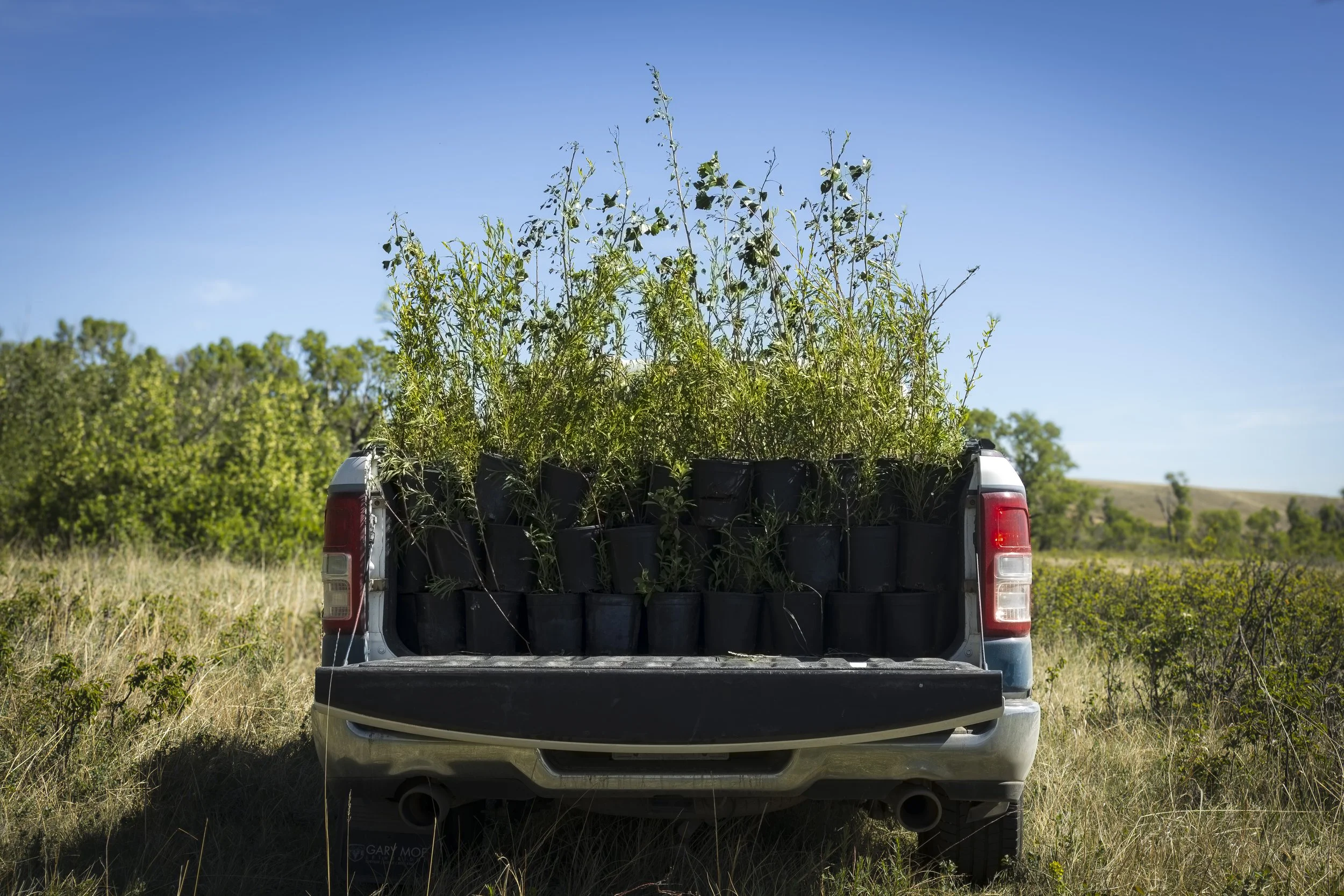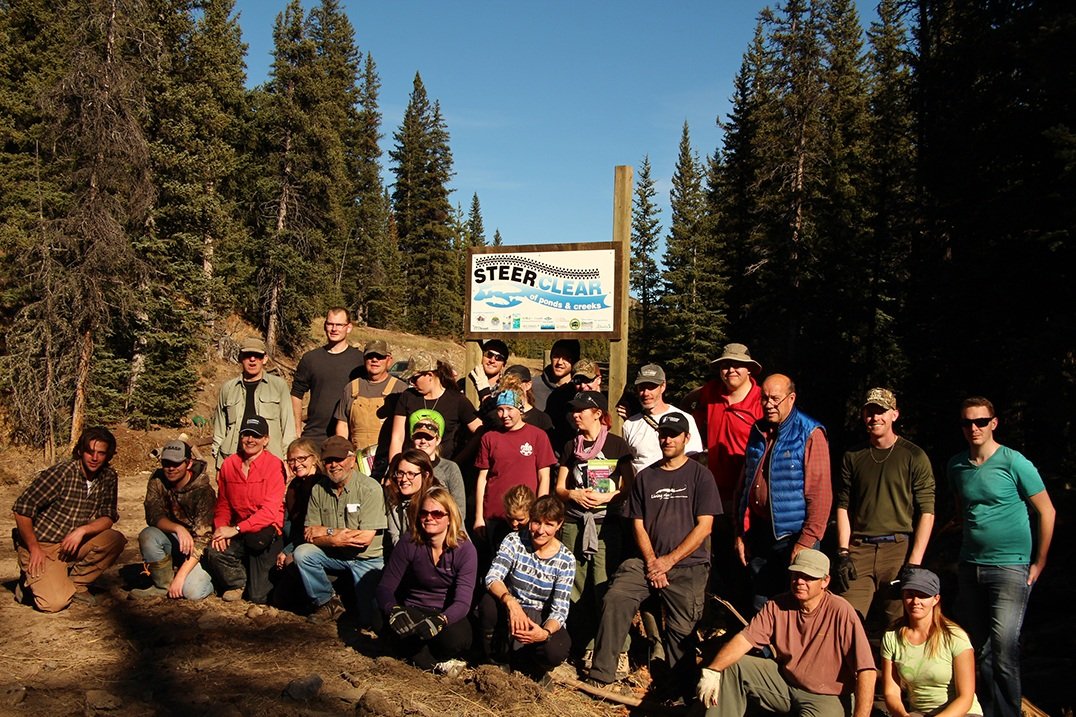Banner: Willow pots soaking in the Belly river before being planted on the banks. Photos and blog by Watershed Stewardship Assistant Rachel Morris.
Right in the middle of May’s first summer heat, we drove to Ninna Piiksii’s house on Kainai Nation. Stacked high in the back of the Oldman Watershed Council (OWC) truck were 125 one-gallon pots, each bearing a rooted willow ready to grow on the banks of the Belly River. The backseat was full of shovels and snacks, ready for Ninna Piiksii, Kallie, Deb, and me (Rachel) to spend a hot day planting willows.
After a morning of planting, we stopped to eat lunch. But first we sat on the riverbank, looking out over the young willows we’d just planted, and the pots we had yet to plant.
We talked about why it was important to undertake projects like this as a community, and how we felt about restoring the landscape. Crouching in the soft mud along the river bank, with the sun beating down on us, I asked, “Why are willows important?” To answer, Ninna Piiksii taught us about ways Blackfoot people use willows, how the willows interact with each other, and about the river we were sitting next to.
This is what he told us, in his own words:
Oki [means hello in Blackfoot]
Good afternoon, it’s blossom month, month of May. My name is Mike Bruised Head, Ninna Piiksii, Chief Bird. It’s a wonderful day by the Belly River, and just further downstream is the confluence where the Belly meets up with Naapi, by the Oldman river.
Today we are planting willows. There’s a huge story on willows. And there’s several species: red willow, diamond willow, golden willow; three or four species in southern Alberta. On the Blackfoot cultural side, the willow is used to make the sweat lodges; it’s the frame for the sweat lodges, for the sweat lodge ceremony. The willow is also used as the frame or the backrest for the Blackfoot backrests you see in Tipis. And also, when framing and stretching small hides back in the day, when there was no choke cherry, bark, or hardwood, it was also used as a frame. There were multiple uses, and some of those are not used today, because of modern age, and loss of traditional Blackfoot science in how to use the willow.
The willow is used abundantly every weekend on the Blood Reserve, and probably on the Blackfoot reserves, Siksika, Piikani, Aamskapi Pikuni, for ceremonial purposes. People put berries or offerings of tobacco, or pray, before they start chopping the willows, that they will grow again or the spirit of the earth beings, the earth spirits, almost asking forgiveness but at the same time thanking all that has grown for helping us.
With the willow itself, I’ve heard this a long time ago: like trees, the roots form an underground network like a willow community where the roots actually help the other roots in terms of holding moisture. And otsiksiistsim, where they water themselves, from the rain, the water, the rivers, from on top, and then it flows down into the ground. But there’s something going on here, why some are drying up. Because the willows grow adjacent to water: streams, river beds, rivers, streams, lakes, ponds, where there’s a lot of moisture. You’re not going to see willows growing in the flat bald headed prairie where there’s no water. You’ll never see that. And so there’s a very strong relationship between the water, in this case Belly river, downstream the Oldman, of all the trees: the willows, the different species, the poplar (some call them cottonwoods) Omahksiikahniikisim, and then there’s an older term for the poplar, Aapootsikahniiksim, ‘inside-out bark tree’. And otsipiiis, that is the name of the willow. Otsipiiis. And plural otsipíiistsi. I’ve seen the usage of the willow. I’ve seen the bark used to make tea, medicine, where the bark is shaved off, cut into small bits, and boiled like tea. And drinking that for medicinal purposes. I’ve also seen those barks where they’re dried and they’re pounded into powder. I’ve seen that too, by the old people.
The willow has always been with us, since the beginning of time. The Creator or Naapi naató’si, the sun, with his son, Morning Star, gave Scarface the gift of the sweat lodge using the willows. The willows go way, way, back, in legendary stories, to the beginning of time, and to point of origin stories. And then I’m just looking at the relationship with these rocks. The rocks maintain the moisture, the mud, and mud is good. Mud is good medicine for willows. They supplement the moisture and the water. So all these go hand in hand, sitting on the bank here, and the ksikkihkimiko, the white soil, and underneath the dark soil, and the type of soil where the willows grow.
The Belly River where we planted, looking upstream (south).
Today, unfortunately, because of drought, overuse of willows, trampling of willows, now we’re planting willows. And sometimes I look at it and find proof it can be done. I think whatever’s in the river systems from pesticides, insecticides, sprays from farming, and whatever oil drilling. There’s something that is also impacting the short life of willows, and that’s in the water. And sitting beside Mokowaansitahtaa, by the belly river, I’m looking at it now.
In the 60s I was raised here, where we’re planting, just on the flat over here. That’s where I was born. I wasn’t born in Cardston hospital. And my grandmother and great grandmother were midwives, and delivered me. I remember then, way back in the early 60s, we’d actually drink the water out of the Belly River. And for things floating in there, like debris, they’d have a tablecloth [as a filter] and they’d empty the pail into the other pail. They didn’t need to boil it; that was just to get whatever was floating on top. There was nothing bad, and the whole reserve got their water. We didn’t get tap water until maybe the mid 70s or late 70s before modernization came in. So the water was okay. So imagine if the water’s healthy and in abundance, then all the plants along the banks of the Belly river and Oldman river, and whatever other river, will all be healthy. But somehow there’s a disruption of that healthy continuity of plant and tree growth along the riverbanks. And right now, I see some weeds that are invasive species. And these invasive species are also taking the moisture, zapping the natural species, because a lot of these weeds are very aggressive. Very aggressive plants. And so that’s the other competition with having a healthy biodiversity, and healthy plant life, and I’m excited today that all these are here, and I’m going to pray in a bit for all these to grow, and that (I’m no spring chicken, but that) in my lifetime I will see that all these we have planted will take root, and grow. I’m going to protect these. I’m not going to allow people to chop them down until there’s a thick row of them, right up to the higher banks of the Belly river.
The Belly River where we planted, looking downstream (north).
I’ve been a member of the board of the Oldman Watershed Council and I’d rather be active, and close to water. I’m a very outdoor person, always been like that, and you’ll see a lot of the Blackfoot people are very outdoors. And that’s just what I’m trying to teach, starting Kainai Ecosystem Protection Association, as president or chairman, is these kinds of things for the young people: rather than getting caught up in technology, modernization, AI, what have you; do that, but also, know your own backyard. Know your plants. Know the invasive species. Know the natural plants. I don’t know how long this river’s been flowing. I teach land-based learning, and I asked a group of people, cohorts, students, masters students and other people. I may pose a question to you, you don’t have to answer: What came first, the river beds with rocks, or the water? What came first? Or did the water, in blackfoot we believe in soyiitapiksi, water beings, did they direct the water where to flow? And looking at the river bed now: rocks, mud, how did they find each other, at the Belly river?
On this side of the mountains, the headwaters stem from the mountain system with the snowpack, the ice melt, the glacier melt; and I’ve pondered that myself: what came first, the water, or the riverbeds? Because the water streams today, they systems sure know where to flow. And the waterbeds; we don’t even know how old, in the middle of the river, how old that water bed is. Again, these are beginning of time stories. We cross the bridges, but we never think about, how old is this river I’m crossing? And how old is the riverbed? I talk a lot about water, but we’ve got to think holistically and think about everything, like these willows today. That is my presentation, this May 28, 2025, and all I know, it’s a really good day.
Like all OWC’s blogs, this post was written by a real live human, without the use of generative AI.










